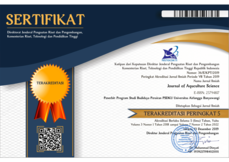Effect Addition of Different Probiotic in Aquaponic Systems towards Water Quality in Aquaculture Catfish (Clarias sp.)
Downloads
Catfish (Clarias sp.) is a type of consumption fish have promising prospects because it has a high enough degree of market uptake. The high market demand which motivated farmers to develop farming aquaponics technologies. Aquaponics, in principle, in addition to conserve land and water use also increases business efficiency through the utilization of nutrients from food remains and fish for plant metabolism. Fish farming with high stocking density causes a decrease in water quality due to the accumulation of organic matter buildup of organic materials causing toxins in the water because there is ammonia (NH3) and nitrite (N02) on the water. The threshold for catfish ammonia content is <0.8 mg /L. Alternative to overcome the problem of water quality in aquaculture is the addition of probiotic. Probiotic contain several types of microorganisms that can help the process of decomposition of ammonia as a bioremediation agent for water quality control. The purpose of this research is to determine the effect of different probiotics in the aquaponics system to water quality. The method that used in this research is experimental with completely randomized design (four treat and five repeated) are P0 (control), P1 (probiotic A), P2 (probiotic B) and P3 (probiotic C). Analysis of data processed using Analysis of Variance. If there are significant differences then continued Duncan's Multiple Range Test. The results showed that the giving of probiotics in the aquaponic system is significantly different (p<0.05).The final conclusion is that the addition of probiotic in the aquaponic system affect the water quality. Based on the results of statistical analysis showed that the levels of ammonia, nitrite and nitrate was lowest for the treatment of P2 is 0.0204 mg /L, 0.012 mg /L and 2.731 mg /L. Ammonia, nitrite and nitrate is highest at P0 treatment (control) is 0.273 mg /L, 0.019 mg /L, 4.218 mg /L.
Keywords :Aquaponic, Catfish, Probiotic, Ammonia, Nitrite, Nitrate, Clarias sp.
Ahmad, R. Z. 2007. Pemanfaatan Khamir Saccharomyces cerevisiae untuk Ternak. Balai Penelitian Veteriner. Bogor. 7 hal.
Aquarista, F., iskandar dan U. Subhan. 2012. Pemberian Probiotik dengan Carrier Zeolit pada Pembesaran Ikan Lele Dumbo (Clarias gariepinus). Fakultas Perikanan dan Ilmu
Kelautan. Universitas Padjajaran. Bandung. 8 hal.
Balai Besar Pengembangan Budidaya Air Tawar (BBPBAT). 2005. Petunjuk Pembenihan Ikan Lele Sangkuriang Clarias sp. Sukabumi.
Dauhan, R. E. S., E. Efendi dan Suparmono. 2014. Efekitvitas Sistem Akuaponik dalam Mereduksi Konsentrasi Amonia pada Sistem Budidaya Ikan. Fakultas Perikanan dan Kelautan. Universitas Lampung. 6 hal.
Direktorat Jenderal Perikanan Budidaya. 2014. Yogyakarta. Konsumsi Lele Tertinggi.http://www.wpi.kkp.go.id/? p=187. Diakses tanggal 20 Februari 2015.
Diver, S. 2006. Aquaponics Integration of Hydroponics with Aquaculture. National Sustainable Agriculture Information Service, Australia.
Effendi, H. 2003. Telaah Kualitas Air Bagi Pengelola Sumberdaya Dan Lingkungan Perairan. Kanisius. hal 55-58.
Harahap, S. T., Mulyadi dan Rusliadi. 2010. Pemeliharaan Benih Ikan Baung (Mystus nemurus) dengan Sistem Bioflok pada Sistem Resirkulasi Akuaponik. Fakultas Perikanan dan Kelautan. Universitas Riau. 7 hal.
Irianto, A. 2003. Probiotik Akuakultur. Cetakan I. Penerbit Gadjah Mada University Press. Bulaksumur. Yogyakarta. 125 hal.
Kusriningrum, R. S. 2012. Buku Ajar Perancangan Percobaan. Cetakan Keempat. Dani Abadi. Surabaya. hal 6-18.
Lisna dan Insulistyowati. 2015. Potensi Mikroba Probiotik_FM dalam Meningkatkan Kualitas Air Kolam dan Laju Pertumbuhan Benih Ikan Lele Dumbo (Clarias gariepinus). Fakultas Peternakan. Universitas Jambi.Mendalo. 8 hal.
Mahyuddin. 2008. Panduan Lengkap Agribisnis Lele. Penebar Swadaya. Jakarta. hal 171.
Pitrianingsih, C., Suminto dan Sarjito. 2014. Pengaruh Kandidat Probiotik Terhadap Perubahan Kandungan Nutrien C,N,P dan K Melalui Kultur Lele Dumbo (Clarias gariepinus). Fakultas Perikanan dan Ilmu
Kelautan. Universitas Diponegoro. Semarang. 10 hal.
Samsundari, S. dan G. A. Wirawan. 2013. Analisis Penerapan Biofilter dalam Sistem Resirkulasi Terhadap Mutu Kualitas Air Budidaya Ikan Sidat (Anguilla bicolor). Fakultas Pertanian dan Peternakan. Universitas Muhammadiyah Malang. Malang. 12 hal.
Tambunan, E. P., U. M. Tang dan Mulyadi. 2010. Cultivation of River Catfish (Mystus nemurus) in Aquaponic Resirculation System With The Addition of EM4. Fakultas Perikanan dan Imu Kelautan Universitas Riau. 6 hal.



















